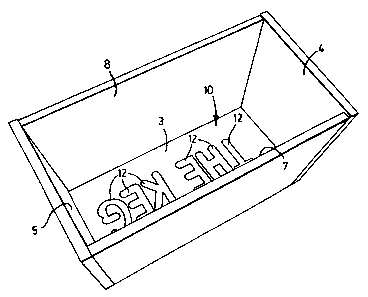Some of the information on this Web page has been provided by external sources. The Government of Canada is not responsible for the accuracy, reliability or currency of the information supplied by external sources. Users wishing to rely upon this information should consult directly with the source of the information. Content provided by external sources is not subject to official languages, privacy and accessibility requirements.
Any discrepancies in the text and image of the Claims and Abstract are due to differing posting times. Text of the Claims and Abstract are posted:
| (12) Patent Application: | (11) CA 2505238 |
|---|---|
| (54) English Title: | BAKERY METHOD AND MOLD THEREFOR |
| (54) French Title: | METHODE DE BOULANGERIE ET MOULE CONNEXE |
| Status: | Deemed Abandoned and Beyond the Period of Reinstatement - Pending Response to Notice of Disregarded Communication |
| (51) International Patent Classification (IPC): |
|
|---|---|
| (72) Inventors : |
|
| (73) Owners : |
|
| (71) Applicants : |
|
| (74) Agent: | HILL & SCHUMACHER |
| (74) Associate agent: | |
| (45) Issued: | |
| (22) Filed Date: | 2005-04-26 |
| (41) Open to Public Inspection: | 2006-03-17 |
| Availability of licence: | N/A |
| Dedicated to the Public: | N/A |
| (25) Language of filing: | English |
| Patent Cooperation Treaty (PCT): | No |
|---|
| (30) Application Priority Data: | ||||||
|---|---|---|---|---|---|---|
|
A mold in one configuration has a pair of generally planar side walls having
joined lower edges and extending upward from the lower edges at an obtuse
angle
to each other and a pair of generally rectangular end walls crosswise to the
side walls
and forming therewith an elongated cavity. A plurality of such side and end
walls can
be joined together at upper edges of the side walls to form a plurality of
such cavities
extending horizontally parallel to one another. Each cavity can also be
provided with
at least one crosswise partition and/or a cover. A foodstuff is made by first
filling the
cavity with a mass of risable dough.
Either before or during baking a branding implement with either recessed or
protruding areas is inserted into the cavity appropriately sized and shaped to
permit
the dough to rise and form around the specific logo or brand desired. The
branding
element can also be fabricated as integral to the cavity. The dough mass is
cooked
so the dough rises and forms a baked food product. The cooked dough mass is
then
demolded exposing the branding.
Note: Claims are shown in the official language in which they were submitted.
Note: Descriptions are shown in the official language in which they were submitted.

2024-08-01:As part of the Next Generation Patents (NGP) transition, the Canadian Patents Database (CPD) now contains a more detailed Event History, which replicates the Event Log of our new back-office solution.
Please note that "Inactive:" events refers to events no longer in use in our new back-office solution.
For a clearer understanding of the status of the application/patent presented on this page, the site Disclaimer , as well as the definitions for Patent , Event History , Maintenance Fee and Payment History should be consulted.
| Description | Date |
|---|---|
| Application Not Reinstated by Deadline | 2011-04-26 |
| Time Limit for Reversal Expired | 2011-04-26 |
| Inactive: Abandon-RFE+Late fee unpaid-Correspondence sent | 2010-04-26 |
| Deemed Abandoned - Failure to Respond to Maintenance Fee Notice | 2010-04-26 |
| Letter Sent | 2009-05-15 |
| Reinstatement Requirements Deemed Compliant for All Abandonment Reasons | 2009-04-27 |
| Deemed Abandoned - Failure to Respond to Maintenance Fee Notice | 2008-04-28 |
| Letter Sent | 2007-09-12 |
| Reinstatement Requirements Deemed Compliant for All Abandonment Reasons | 2007-08-22 |
| Inactive: Office letter | 2007-05-22 |
| Deemed Abandoned - Failure to Respond to Maintenance Fee Notice | 2007-04-26 |
| Application Published (Open to Public Inspection) | 2006-03-17 |
| Inactive: Cover page published | 2006-03-16 |
| Inactive: IPC removed | 2005-08-18 |
| Inactive: IPC assigned | 2005-08-18 |
| Inactive: IPC assigned | 2005-08-18 |
| Inactive: First IPC assigned | 2005-08-18 |
| Inactive: IPC assigned | 2005-08-18 |
| Application Received - Regular National | 2005-05-27 |
| Filing Requirements Determined Compliant | 2005-05-27 |
| Inactive: Filing certificate - No RFE (English) | 2005-05-27 |
| Small Entity Declaration Determined Compliant | 2005-04-26 |
| Abandonment Date | Reason | Reinstatement Date |
|---|---|---|
| 2010-04-26 | ||
| 2008-04-28 | ||
| 2007-04-26 |
The last payment was received on 2009-04-27
Note : If the full payment has not been received on or before the date indicated, a further fee may be required which may be one of the following
Please refer to the CIPO Patent Fees web page to see all current fee amounts.
| Fee Type | Anniversary Year | Due Date | Paid Date |
|---|---|---|---|
| Application fee - small | 2005-04-26 | ||
| 2007-04-19 | |||
| Reinstatement | 2007-08-22 | ||
| MF (application, 2nd anniv.) - small | 02 | 2007-04-26 | 2007-08-22 |
| MF (application, 4th anniv.) - small | 04 | 2009-04-27 | 2009-04-27 |
| MF (application, 3rd anniv.) - small | 03 | 2008-04-28 | 2009-04-27 |
| Reinstatement | 2009-04-27 |
Note: Records showing the ownership history in alphabetical order.
| Current Owners on Record |
|---|
| SALVATORE MESSINA |
| Past Owners on Record |
|---|
| None |